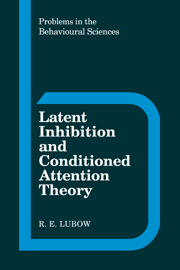Book contents
- Frontmatter
- Contents
- Preface
- 1 Introduction
- 2 Latent inhibition testing procedures
- 3 Variables affecting latent inhibition
- 4 Organismic variables affecting latent inhibition
- 5 Associative learning tests of the effects of stimulus preexposure in children and adults
- 6 Neural substrates of latent inhibition
- 7 Theories and explanations of latent inhibition in animals
- 8 Conditioned attention theory of latent inhibition
- 9 Conditioned attention theory as applied to latent inhibition in humans
- 10 Some applications of conditioned attention theory: learned helplessness and schizophrenia
- Notes
- References
- Author index
- Subject index
5 - Associative learning tests of the effects of stimulus preexposure in children and adults
Published online by Cambridge University Press: 13 October 2009
- Frontmatter
- Contents
- Preface
- 1 Introduction
- 2 Latent inhibition testing procedures
- 3 Variables affecting latent inhibition
- 4 Organismic variables affecting latent inhibition
- 5 Associative learning tests of the effects of stimulus preexposure in children and adults
- 6 Neural substrates of latent inhibition
- 7 Theories and explanations of latent inhibition in animals
- 8 Conditioned attention theory of latent inhibition
- 9 Conditioned attention theory as applied to latent inhibition in humans
- 10 Some applications of conditioned attention theory: learned helplessness and schizophrenia
- Notes
- References
- Author index
- Subject index
Summary
Although the vast majority of experiments on latent inhibition have used animals as subjects, there has been increasing interest in the phenomenon as it occurs in humans. Because the normal procedures for producing latent inhibition are effective with children, but not with adults, who require a masking task, it is convenient to examine separately these two populations of subjects.
Children
The study of stimulus preexposure effects, using children as subjects, has not received much attention in the literature. Indeed, the work can be assigned almost in toto to the activities of three different laboratories. The earliest research, that of Cantor and his associates, concentrated on the effects of stimulus familiarity on reaction time (Cantor, 1969a,b). These efforts were continued by Kraut and Smothergill (e.g., Kraut, 1976; Kraut & Smothergill, 1980; Smothergill & Kraut, 1980), who started from a cognitive theoretical base (Posner, 1978; Posner & Boies, 1971). On the other hand, Lubow and his colleagues (e.g., Lubow, Alek, & Arzy, 1975; Kaniel & Lubow, 1986) have explored stimulus familiarity primarily within the context of its effects on subsequent learning. Because there is general agreement that the stimulus preexposure effect that is termed “latent inhibition” involves a learning deficit, the reaction-time studies will be omitted from this review.
Whereas the stimulus familiarization effect is based on reaction-time studies, stimulus preexposure also has decremental effects on later learning when the previously familiarized stimulus is employed as a conditioned or a discriminative stimulus, one to which new associations must be acquired.
- Type
- Chapter
- Information
- Latent Inhibition and Conditioned Attention Theory , pp. 108 - 129Publisher: Cambridge University PressPrint publication year: 1989

